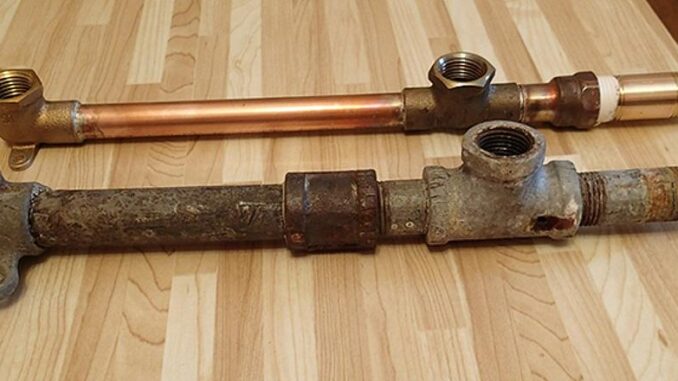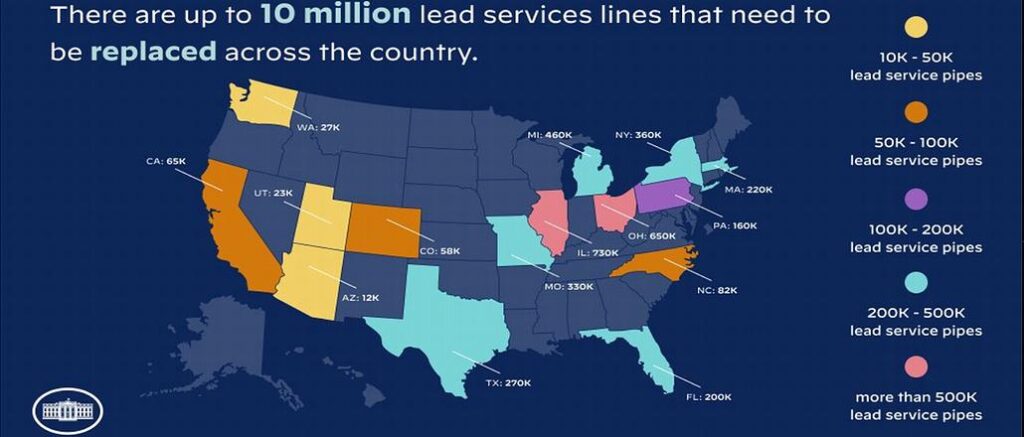
WASHINGTON, DC, October 11, 2024 (ENS) – To reduce the poisonous contamination of lead in American drinking water, the U.S. Environmental Protection Agency Tuesday issued the long-awaited final Lead and Copper Rule Improvements measure. As a practical matter, this means proactive replacement of lead service lines nationwide within the next 10 years, part of President Joe Biden’s commitment to ensure that all communities can drink clean water when they turn on the tap.
More rigorous testing of drinking water is required, improved sampling methods will more accurately measure lead levels, and more water systems will have to take immediate action to protect consumers from lead exposure in their water by replacing old, corroded lead water pipes with copper or plastic.
The new rule also requires water systems to provide consumers with filters when high lead levels are repeatedly detected.
The EPA is making these necessary changes after the Bipartisan Infrastructure Law, enacted by Congress and President Biden in November 2021, set aside $15 billion dollars for lead service line removal.
“We’ve known for decades that lead exposure has serious long-term impacts for children’s health. And yet, millions of lead service lines are still delivering drinking water to homes,” said EPA Administrator Michael Regan.
“President Biden is putting an end to this generational public health problem. With the Lead and Copper Rule Improvements and historic investments in lead pipe replacement, the Biden-Harris Administration is fulfilling its commitment that no community, regardless of race, geography, or wealth, should have to worry about lead-contaminated water in their homes,” Administrator Regan said.
The EPA estimates that drinking water can make up 20 percent or more of a person’s total exposure to lead. And that infants who consume mostly mixed formula can receive 40 percent to 60 percent of their exposure to lead from drinking water.
EPA estimates that at least nine million homes are served through legacy lead pipes across the country. Many of them are in lower-income communities and communities of color, creating a disproportionate lead exposure burden for these residents.
“Eliminating lead exposure from the air people breathe, the water people drink, and the homes people live in is a crucial component of the Biden-Harris Administration’s historic commitment to advancing environmental justice,” the EPA said in a statement announcing the new rule October 8.
What’s the Harm?
“While copper is very resistant to corrosion, untreated lead pipes and plumbing tend to corrode over time. When drinking water comes in contact with lead pipes and plumbing, for extended periods of time, corroded lead particles can enter your drinking water,” according to the Passaic Valley Water Commission in New Jersey.
The millions of lead service lines remaining in the United States deliver drinking water to an estimated 22 million people though pipelines made of lead, a highly toxic contaminant that leaches into the water.
A federal Agency for Toxic Substances and Disease Registry, ATSDR, study of the health effects of oral exposure to lead (Pb) through contaminated water or food concludes, “The health effects of Pb are diverse, and exposure to Pb is associated with toxicity to every organ system.”
In children, the ATSDR study found, “Decreased cognitive function; altered mood and behaviors that may contribute to learning deficits, altered neuromotor and neurosensory function, peripheral neuropathy, and encephalopathy.”
In adults, the study found, “Decreased cognitive function including attention, memory, and learning; altered neuromotor and neurosensory function; altered mood and behavior; and decreased
peripheral nerve conduction velocity.”
The Center for Disease Control and EPA agree: no level of lead is safe to ingest. Even trace amounts of lead can cause irreversible damage to children’s developing brains, cognitive impairment, and behavioral issues.
Exposure to lead is also linked with risks to heart and kidney health, decreased resistance to disease, sensitization, autoimmunity, and inflammation, the ATSDR reports. And, alarmingly, the agency reports “Increased risk of death from all causes (including cancer and cardiovascular disease)…”
Congress knew the dangers of lead exposure when they banned installation of lead service lines in 1986, and when the Lead and Copper Rule took effect in 1991. But there has been no meaningful improvement in protecting communities under the Lead Copper Rule for over 30 years, until now.

Flint, Michigan Water Crisis
The public health water crisis in the industrial city of Flint, Michigan started in 2014. During a financial crisis, state-appointed emergency manager Darnell Earley changed Flint’s water source from the Detroit Water and Sewerage Department – sourced from Lake Huron and the Detroit River – to the Flint River. Although residents complained about the taste, smell, and look of the water, officials failed to apply corrosion inhibitors to the water.
As a result, lead from aging pipes leached into the water supply, exposing around 100,000 residents to elevated lead levels. A pair of scientific studies confirmed that lead contamination was present in the water supply. The city switched back to the Detroit water system on October 16, 2015, and later signed a 30-year contract with the new Great Lakes Water Authority in 2017.
Mona Hanna, a Flint, Michigan pediatrician and associate dean for public health at Michigan State University College of Human Medicine, called the new rule covering lead pipes, “A game changer for kids and communities.”
“EPA’s finalized lead and copper rule improvements will ensure that we will never again see the preventable tragedy of a city, or a child, poisoned by their lead pipes,” Dr. Hanna said. “I commend the Biden-Harris administration for their steadfast efforts to finally update this ancient rule, and I am thrilled that this rule proactively centers our children and their potential. The children win!”
Since the revelations in Flint, dozens of U.S. cities have been found to have dangerously elevated levels of lead in homes, schools, and daycare centers. High lead levels have been found in tap water in Baltimore, Maryland; Buffalo, New York; Benton Harbor, Michigan; Chicago, Illinois; Milwaukee, Wisconsin; Newark, New Jersey; New York City and Syracuse, New York; Pittsburgh, Pennsylvania; and Washington, D.C.
One analysis by the nonprofit Natural Resources Defense Council found that between 2018 and 2020, 56 percent of the U.S. population drank from water systems with detectable levels of lead.
The rule improvements were greeted by a chorus of welcoming comments from the environmental community.
Sierra Club’s Legislative Director Melinda Pierce said, “The Lead and Copper Rule Improvements rule represents an important step forward in protecting public health, particularly for the most vulnerable. By requiring the removal of most lead service lines and mandating quicker action, the EPA is finally addressing a critical threat to the health of millions, particularly children and communities of color.”
“Lead contamination is a longstanding public health emergency, and the Biden-Harris Administration’s rule is a monumental step forward in addressing the urgent need for safe, clean drinking water,” Earthjustice Vice President of Litigation for Healthy Communities Patrice Simms said.
Speaking for the public interest environmental law firm Earthjustice, Simms said, “Moving forward, water utilities, regulators, and legislators must work together to build off this rule and fulfill the administration’s vision for complete removal of all lead service lines in 10 years. Every day that lead pipes remain in the ground is a day our children’s futures are at risk. And this removal must be equitable – many families have paid with their health, and those families should not also be required to pay for the country to address this public health problem.”
Communities Tackle Lead Pipes
• Milwaukee Water Works is on track to replace all remaining lead pipes within the EPA’s 10-year timeframe. In 2024 alone, Milwaukee received approximately $30 million in Bipartisan Infrastructure Law funding to replace 3,400 lead service lines.
• The Detroit Water and Sewerage Department has received $90 million from the Administration and will replace more than 8,000 lead service lines this year, putting the city on track to replace all lead pipes in 10 years.
• The Erie, Pennsylvania Water Works has received $49 million from EPA to enable the city to replace all lead pipes within 5 years instead of 25 years.
• Denver Water has accelerated its efforts through $76 million from the Bipartisan Infrastructure Law, allowing the city to be on track to replace all lead pipes within a decade.
The Lead and Copper Rule Improvements will help protect millions of Americans from exposure to lead in drinking water. EPA estimates that on average, every year after the LCRI is issued it will:
- protect up to 900,000 infants from having low birthweight.
- prevent Attention-Deficit Hyperactivity Disorder (ADHD) in up to 2,600 children.
- reduce up to 1,500 cases of premature death from heart disease.
- prevent up to 200,000 IQ points lost in children.
Investments in identifying lead pipes, planning for their removal, and replacing them will create jobs in local communities while strengthening the foundation of safe drinking water that supports economic opportunity.
The benefits of reducing lead exposure are extensive. The Federal Reserve Bank of Chicago lists them as: “improved health, reduced health care costs, reduced risks of crime and incarceration, increased educational achievement and incomes, longer life spans, and improved quality of life.”
For more information about the final rule, including a pre-publication version of the Federal Register notice and fact sheets, visit the rule webpage.
Featured image: A corroded lead water pipe, foreground, and a copper water pipe that doesn’t corrode or leach lead into the drinking water that passes through it. (Photo courtesy U.S. EPA)



